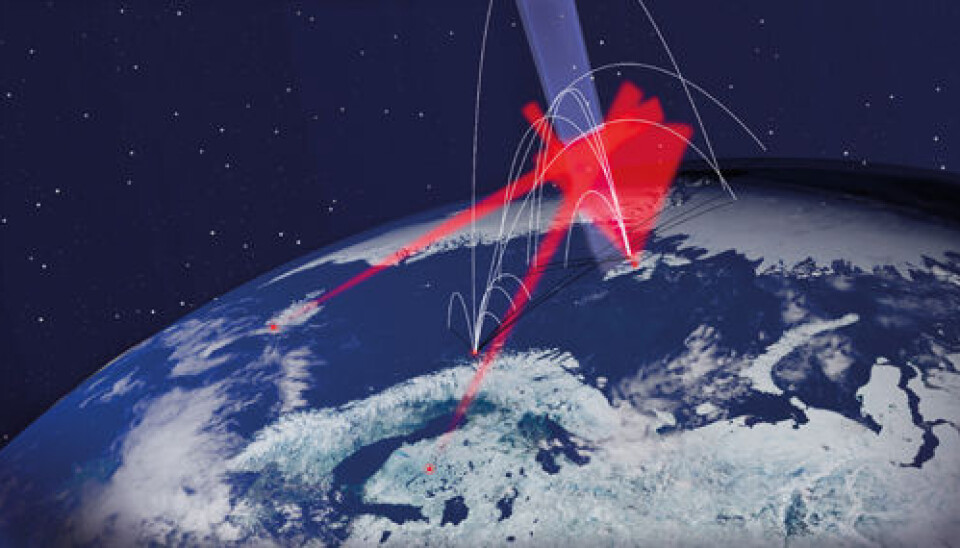
Eleven rockets set to reveal the mysteries in the Earth's atmosphere
In cooperation with NASA and the Japanese Aerospace Exploration Agency, scientists at the University of Oslo are now set to reveal the mysteries of physics in the atmosphere by launching eleven rockets.
This article was originally published on Apollon - Research magazine from The University of Oslo. Read the original article.
Just before Easter a delegation from the University of Oslo travelled to Japan to sign a joint venture agreement with the American space agency, NASA, and the Japanese Aerospace Exploration Agency, JAXA. Their aim is to understand more about what happens when violent solar storms hit the Earth.
As pointed out by Professor Kristian Birkeland over one hundred years ago, it is well known that solar flares create fantastic displays of the northern lights on Earth. In recent times it has also become a well known fact that solar flares cause problems for both satellites and navigation systems.

Despite 30 years of relentless studies, scientists still lack the basic knowledge required for predicting when such problems will occur. Once they understand this, it should be possible to make good space weather forecasts just like we do with our weather forecasts on Earth.
"Space weather forecasts are important for being able to predict when navigation systems and communications with satellites will not work as expected," says Professor Jøran Moen at the Department of Physics at the University of Oslo in Norway.
The desire for better space weather forecasts is the most important reason why NASA and JAXA are involved in this collaborative research.
"Norway has some of the world's leading experts in this field, with many decades of experience. This joint venture is providing us with completely new insights into how the upper part of the Earth's atmosphere converts energy from the Sun." Douglas E Rowland, an astrophysicist at NASA, points out: "The most important thing for us is to gain a better understanding of our options for knowing how we can predict space weather, although it would normally take several years from the time when we discover and understand our observations before we can use them and improve our space weather forecasting models."
– Historic

This joint venture is called Grand Challenge Initiative (GCI) Cusp and is being led by UiO's Jøran Moen and Kolbjørn Blix at the Andøya Space Centre in Northern Norway.
Over the course of the next two years this international team will launch eleven rockets over Svalbard from Andøya, the northernmost island in the Vesterålen archipelago in the country of Nordland, and from Ny Ålesund on the western coast of Svalbard.
This will be the most comprehensive attempt ever to have taken place using rockets for research purposes.
"We will try to launch four of the rockets at the same time. This has never been done before. It is a historic venture," Moen points out.

"The four parallel rockets are important for us. By using them we can obtain much better scientific results than would have been the case if we had just launched one rocket at a time," points out Professor Yoshifumi Saito from the Japanese Aerospace Exploration Agency, JAXA.
Nine of the eleven rockets are from NASA. They are being shipped from NASA's headquarters in the USA to the space centre on Andøya. Some of them will then be shipped onwards to Svalbard.
"This is the largest international shipment of rockets ever to have been made by the American space centre.
The rockets cost around NOK 400 million. The largest ones are 21 metres long and weigh six tonnes," says Kolbjørn Blix.

One of the rockets will be built by the UiO. It will be assembled over the course of one year at the space centre on Andøya. If everything goes according to plan, the rockets will be launched from Ny Ålesund in January 2019.
"The Norwegian rockets will cost around NOK 15 million," says Kolbjørn Blix. The instruments will cost extra.
Mysteries way up in the atmosphere
The rockets, which will be jam-packed with monitoring instruments, will reveal the mysteries in the Earth's upper atmosphere. This part of the atmosphere is called the ionosphere which is located 80 to 800 kilometres above the Earth.
The gas there is electrically charged and is known as plasma. The ionosphere is important for radio communications because it reflects radio waves back to Earth.
Solar flares consist of electrically charged particles. They are attracted by the magnetic fields in the ionosphere around the Earth's polar regions. This is the reason why the Northern Lights can only be observed in the far north or the far south.
"Svalbard is the best place on Earth for observing how the solar wind connects with the Earth's magnetic field," says Moen.
It is pitch black on Svalbard during the months of December and January. It is then possible to observe this phenomenon by using optical cameras from the Kjell Henriksen Observatory outside Longyearbyen. The scientists will be making use of the radar facility which is located just a few hundred metres away. Without these two high-tech facilities, it would not be possible to know the best time for launching the rockets.
Turbulent chaos
When solar storms rain down on the Earth, they cause turbulence in the ionosphere. This causes disruption to both navigation systems on Earth and aircraft radio signals. Today turbulence is one of the last major unsolved problems of classical physics. The physicists are hoping that the rockets will make it possible reveal exactly how turbulence can be explained.
"Without such an understanding of turbulence it is impossible to make the calculations needed for being able to predict severe space weather events.
All eleven rockets will be used for making scientific measurements in part of the Earth's upper atmosphere known as the cusp.
This is the area where the northern lights occur, producing various strange and inexplicable phenomena.
In order to understand this, you first need to understand the difference between night-time and daytime northern lights.
Briefly speaking, daytime northern lights occur when the Sun's magnetic storms hit the Earth from the front, i.e. on the side of the Earth facing the Sun. Daytime northern lights occur between 200-300 kilometres above the surface of the Earth.
When the magnetically charged particles in solar storms pass the Earth, they attach themselves to the magnetic field on the far side of the Earth. Due to the tremendous speed of these storms, which at their most intense can be over three million kilometres per hour, the magnetic field stretches out like an elastic band.
When the elastic band is stretched to the maximum, it rebounds towards the Earth with huge energy and penetrates deep into the atmosphere, down to a depth of a hundred kilometres about the Earth's surface. This is where the night-time northern lights occur.
It is the reason why the night-time northern lights are much more powerful and far more spectacular than the daytime northern lights.
"The night-time northern lights can actually be one hundred times stronger than the daytime northern lights.
The night-time northern lights are at their most powerful at a latitude of 70 degrees north, i.e. the same latitude as that of Tromsø. The daytime northern lights are best observed at a latitude of 80 degrees north, i.e. the same latitude as that of Svalbard.
Gigantic fountains of air
Solar storms do not just create turbulence and disruptions in the atmosphere. They also heat up the atmosphere.
You may well recall from your physics lessons at school that hot air requires more space than cold air.
Since the night-time northern lights occur a long way down in the atmosphere, the pressure exerted by the air above will hold the hot air down – just like in a pressure cooker.
In the upper areas, where the daytime northern light heat up the atmosphere, there is nothing to prevent the hot air from being forced upwards.
The daytime northern lights consequently form gigantic fountains of air. These fountains are 50,000 kilometres long and pump out as much as 300 tonnes of oxygen per day.
Even though it is completely logical that this air rises, scientists do not yet understand why the energy of the air being pumped out is so powerful that the air molecules escape from the Earth's gravitational field and disappear out into the universe.
"A transformation of energy takes place somewhere within this fountain of air which causes an increase in the speed of the particles, but we don't yet know why this happens. We only know that it occurs at least 600 kilometres above the surface of the Earth and that the energy moves in waves."
In order to escape from the Earth, the air particles accelerate to a speed of eleven kilometres per second, which is extremely fast.
This strange physical phenomenon cannot be investigated by using radar monitoring from either the ground or from a satellite.
"Only these rockets will be able to provide us with the answer to the cause of this acceleration."
The physicists are not just interested in the theoretical aspects of these fountains of air.
"Even though you cannot see that the atmosphere is expanding from the ground, the air resistance created by these fountains of air acts as a brake on satellites, causing then to drop down from their trajectories. The satellites therefore require fuel in order to increase their speed again. At the moment there are no models which are able to predict when this will occur. Good space weather forecasts would help to extend the life of our satellites," says Jøran Moen.
Most satellites orbit at a height of 400-600 kilometres above the Earth. Even those which orbit at a height of 800 kilometres can be affected by the fountains of air.
"The lower a satellite has its orbit, the greater the braking effect exerted by the air fountains."
Rockets will complement each other
The Japanese Aerospace Exploration Agency, JAXA, will be launching the first rocket this coming December.
"This rocket will investigate the waves of energy which cause the fountains of air. This will be the first one of the eleven rockets to be launched in this GCI cusp joint venture collaboration, This event will be used like a "magnet" in order to recruit more scientists to develop an interest in rocket data. We do expect that Japanese observations to result in new knowledge to even better define the launch conditions for the other ten rockets to go in 2018-2019."
Everyone who has ever tried to see the northern lights knows that this beautiful phenomenon is unstable and that its location is constantly changing.
"The most important purpose of the Japanese rocket is to learn the best way of ensuring how this phenomenon can be found. This will be important when the scientists prepare to launch four rockets in parallel.
This is the main issue. Up until now space scientists have only launched one research rocket at a time. This method has one big weakness because only linear measurements are acquired.
Two of the four simultaneous rockets will be launched from Andøya. The other two will be launched from Ny-Ålesund. Since all four rockets need to be launched at the same time, the scientists need more launch pads. This cannot be achieved without an extra NOK 30 million launch pad in Ny-Ålesund.
"We will need 40-50 men on the ground for the four parallel launches," says Kolbjørn Blix.
The rockets will be launched through the air fountain at different heights.
"The rockets will look at the transfer of energy which takes place, i.e. how much energy is coming in, the form it takes and how the air accelerates upwards," explains Moen.
It is not just the satellite owners who will benefit from this new knowledge.
"This new knowledge is important for understanding how the Earth's magnetic field protects us. Once we understand how solar storms force oxygen away from the Earth, we will also be able to understand how other planets are able to retain or lose their atmospheres.
3D measurements
The scientists will launch one rocket with twelve "daughters". These "daughters" will travel in parallel with the rocket. In this way the scientists will be able to obtain 3D images from the ionosphere for the first time.
"3D measurements are essential for being able to distinguish between physical phenomena in the plasma," says Moen.
One of the rockets is a Norwegian-American student rocket.
"It will enable the students to learn about how they can make electronic instruments which will work and be able to withstand the enormous pressures which exist inside a rocket.
When the rockets are launched, large areas of airspace will be closed off.
"Some of the rockets will reach heights of one thousand kilometres. This is three times higher than the orbit of the International Space Station. After 24 minutes they will plummet down through the ice to the north of Svalbard," explains Kolbjørn Blix.
Data sharing
In the past all scientists who were involved in researching the northern lights used to sit on their own data. Now the data collected by these rockets will be stored in a common database on Svalbard.
"If anything goes wrong with one of the rocket, that rocket team will be able to continue researching the data received from the other rockets."
The format of the data is standardised so that it will be easy to compare and share it.
"I want as many as people as possible to analyse the data obtained from the same phenomena so that we can make fast progress," says Moen.






























